Marine Biologists: Champions of Shark Conservation
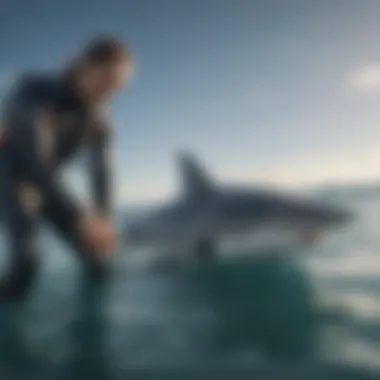
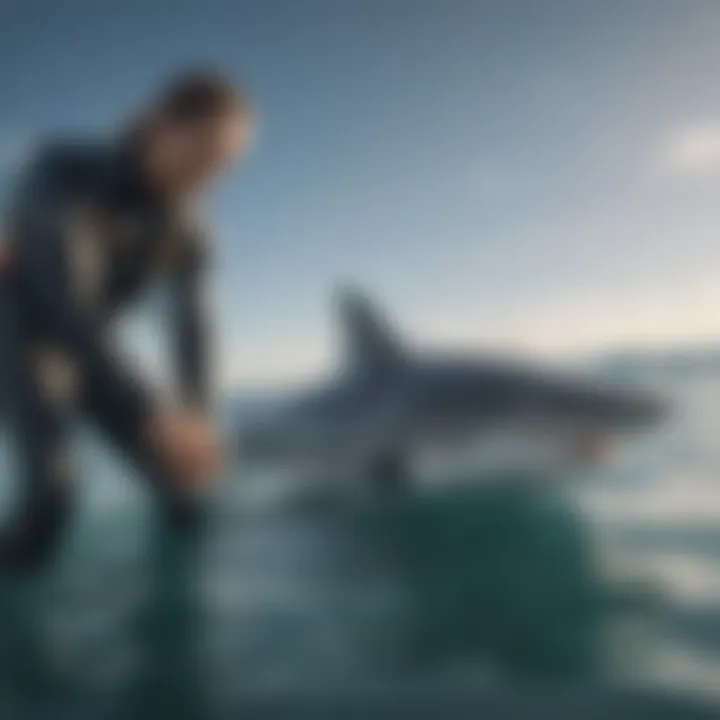
Intro
Sharks have long evoked a sense of fascination and fear. As apex predators, they play a crucial role in maintaining the balance of marine ecosystems. However, their populations are in peril due to overfishing, habitat loss, and pollution. Marine biologists dedicate themselves to understanding sharks and the challenges they face in their natural habitats. This article will explore their essential contributions to shark conservation, focusing on the methods they use, the ecological importance of these creatures, and the pressing conservation issues that keep them awake at night.
By combining fieldwork, scientific research, and policy advocacy, marine biologists serve as key players in the efforts to save sharks from the brink of extinction. This narrative will shine a spotlight on how they navigate the choppy waters of conservation work, using innovative techniques to gather data, develop sustainable practices, and effectively communicate their findings to the public and policymakers.
The Importance of Sharks
Sharks are often misunderstood. As the guardians of ocean health, they regulate other species and help keep marine ecosystems intact. Without them, we risk creating an imbalance that can lead to the collapse of fish populations and degradation of habitats.
This ecosystem role underscores why it’s vital to conserve sharks. Marine biologists execute intricately designed research projects that map out the behaviors, breeding patterns, and population dynamics of sharks. Their work not only sheds light on these magnificent creatures but aids in formulating strategies that combat human impacts on shark populations.
The Challenges Ahead
The road to shark conservation is fraught with challenges. Marine biologists must contend with limited funding, political hurdles, and public misconceptions. Their work often involves collaboration with various stakeholders, including fishermen, conservation organizations, and policymakers, to foster understanding and implement sustainable practices.
"Saving sharks is not just about protecting a species; it's about safeguarding entire ecosystems."
Research Methodologies
Marine biologists employ a variety of research methodologies to gather data on shark populations. Here are some common techniques used:
- Telemetry: Tracking sharks using tags that send data on their movements.
- Environmental DNA (eDNA) Sampling: Collecting samples from the water to identify different shark species present in an area.
- Population Surveys: Conducting visual surveys and catch assessments to evaluate population dynamics.
- Behavioral Studies: Observing sharks in their natural setting to understand their behaviors and interactions.
Through these methods, marine biologists paint a clearer picture of shark populations, helping to inform effective conservation measures.
Policy Advocacy
In addition to research, marine biologists often engage in policy advocacy to promote shark conservation. They collaborate with legislative bodies to draft and implement protection laws, work on sustainability initiatives, and educate the public about the importance of sharks to ocean health.
Their recommendations can lead to significant changes in fishing regulations, habitat protections, and resource management strategies. Through these policy efforts, they strive to ensure that sharks can thrive for generations to come.
Culmination
Marine biologists are at the forefront of shark conservation, combining rigorous scientific research with active engagement in policy and education. Their work is integral to the future of sharks and the oceans that rely on their presence. As we deepen our understanding of these elusive creatures, it becomes clear that protecting sharks is not just key to conserving a single species; it is vital for preserving the health of our entire marine ecosystems.
Foreword to Marine Biology and Sharks
Understanding marine biology is essential, especially when it comes to investigating and conserving shark populations. These creatures have roamed the oceans for millions of years, yet their existence is increasingly threatened by human activities. Marine biologists are crucial in navigating the complexities of ecosystems, studying various shark species, and fostering a better relationship between humans and the marine environment. The topic sets the groundwork for evaluating how dedicated research can shed light on shark behavior and conservation measures.
By introducing fundamental aspects of marine biology and detailing the importance of sharks within these ecosystems, this article aims to paint a clearer picture of their roles and the pressing need for their preservation. As we delve deeper, we will explore the various dimensions marine biologists tackle in their quest to understand and protect these apex predators.
Defining Marine Biology
Marine biology is the scientific study of organisms in the ocean and other saltwater environments. This includes the behavior of organisms, their interactions with the ecosystems around them, and the impact of environmental changes on marine life. From the tiniest microbes to giant whales, marine biologists dive into a vast array of aquatic conditions.
In the context of sharks, marine biology becomes particularly significant. Sharks, being apex predators, have unique roles that help maintain the health of marine ecosystems. They can influence prey populations, which in turn affects the entire food web. Important aspects include:
- Assessing species diversity.
- Understanding reproductive habits.
- Examining the effects of pollutants in oceans.
Together, these factors contribute to a holistic understanding of marine ecosystems, making marine biologists indispensable for shark conservation efforts.
The Evolution of Shark Research
Shark research has come a long way since early sailors’ tales of monstrous sea creatures. Historically, many cultures viewed sharks as fearsome beasts rather than vital components of marine ecology. However, as the scientific community began to focus its ey on marine environments, framework for understanding shark biology steadily developed.
The introduction of field studies in the 20th century marked a pivotal moment. Researchers employed various techniques such as:
- Tagging and tracking to understand migratory patterns.
- Life history studies seeking to evaluate growth rates and reproduction.
- Population dynamics to assess factors affecting their numbers.
Furthermore, advances in technology, like underwater cameras and bioacoustics, have provided unprecedented insights into shark behavior and habitats. Marine biologists today leverage these tools to challenge myths and inform conservation policies.
Through the exploration of these developments, we see the gradual shift towards an appreciation of sharks as critical guardians of marine health rather than simply fears lurking in the deep.
"Marine biology is not just about studying the deep; it is about bridging the gap between our worlds and the vast oceans where these magnificent creatures thrive."
In summary, the evolution of shark research underscores the need for continuous scientific inquiry as a vital element in the fight for their conservation.
Shark Species Diversity

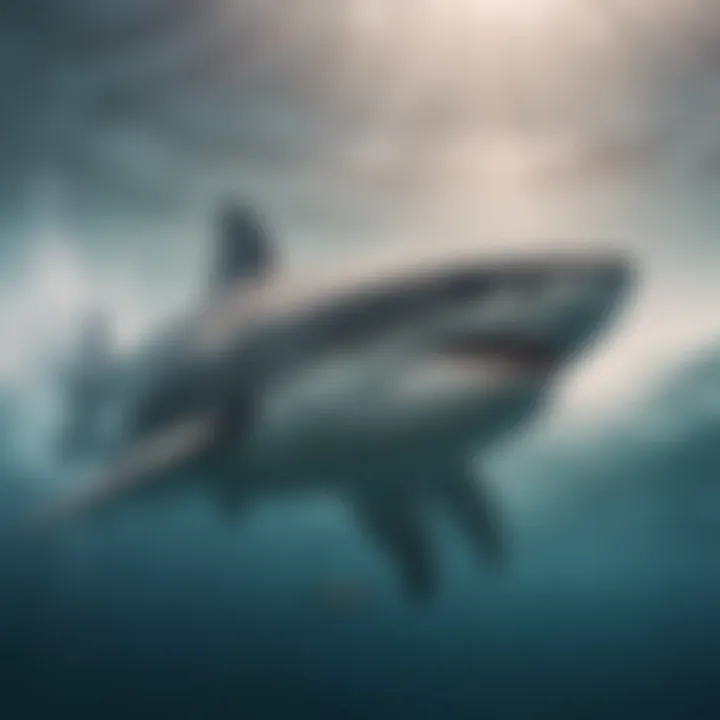
Understanding shark species diversity plays a crucial role in any comprehensive discussion about marine biology and conservation. Sharks are not a monolithic group; rather, they encompass over 500 species, each carving out its own niche in the marine ecosystem. This diversity means that they contribute differently to the environment and require tailored conservation strategies. By recognizing these species, marine biologists can better assess which groups are thriving and which are faltering against the looming threats of climate change, overfishing, and habitat destruction.
For instance, while species like the great white shark have a formidable presence in popular culture, many lesser-known species play equally significant roles in maintaining ecological balance. Understanding the intricate web of life that sharks participate in can illuminate paths toward effective conservation policies. Moreover, species diversity can often serve as an indicator of ocean health, reflecting both the status of marine ecosystems and the advent of human impact.
Common Species of Sharks
Among the various species, several stand out due to their frequency and importance in marine environments. Common species like the tiger shark, hammerhead shark, and the bull shark can be spotted in various coastal waters worldwide. These sharks are often not only vital predators but also indicators of marine ecosystem health. Their predatory nature helps control the populations of prey species, which keeps the marine food web in balance.
- Tiger Shark: Known for their broad diet, tiger sharks consume a variety of prey, playing a critical role in regulating species populations.
- Hammerhead Shark: This species is recognized for its distinctive head shape, which enhances its ability to spot prey.
- Bull Shark: Adaptable to both marine and freshwater environments, this species contributes to the diversity of coastal habitats.
Common shark species are often the focus of both research and public outreach, as familiarity can breed interest and investment in conservation efforts.
Rare and Endangered Sharks
In stark contrast to their more common cousins, many species of sharks are at risk of extinction. Sharks like the thresher shark, whale shark, and the sawfish are among those listed as vulnerable or endangered by organizations such as the International Union for Conservation of Nature (IUCN). Their rarity underscores the urgency of conservation initiatives, as their loss can lead to significant disruptions within marine ecosystems.
- Thresher Shark: Recognizable by their long tails, they are often targeted in fisheries for their meat and fins, resulting in declining populations.
- Whale Shark: The largest fish in the ocean, they are gentle giants that face threats from fishing and shipping traffic.
- Sawfish: With their distinctive rostrum, they are critically endangered, primarily due to habitat destruction and entanglement in fishing gear.
With such species, the narrative is sobering. The decline of these sharks is frequently tied to human activity, be it through direct overfishing or broader ecological impacts. Marine biologists, aware of these dangers, dedicate resources to studying these rare species, aiming to promote protective measures and rehabilitate their populations.
"The diversity of sharks is not just fascinating; understanding it is essential for sustainable marine ecosystems and ensuring that these ancient predators continue to thrive in our waters."
Research Methodologies in Shark Studies
Understanding the research methodologies behind shark studies is paramount, especially in a world increasingly aware of the ecological importance of these apex predators. Marine biologists rely on a multitude of techniques to gauge the health of shark populations, analyze their behaviors, and determine their ecological roles. These methodologies not only contribute to academic knowledge but also shape conservation strategies and policies.
Field Studies and Data Collection
Field studies form the backbone of marine biology, providing critical real-world data. Marine biologists often venture into the ocean to monitor shark populations directly. They engage in activities like tagging, which can involve physically capturing a shark to affix an ID tag. This allows scientists to track migrations and understand their movement patterns over time.
Such fieldwork is labor-intensive but crucial for acquiring accurate population estimates. Data collection methods can range from simple observational studies to more complicated ones involving the use of nets and underwater cameras. For instance, a team might spend weeks on a research vessel, observing the sharks' behavioral patterns in various environments. The culmination of these studies offers insights into how human activities impact these creatures.
Use of Technology in Research
Satellite Tracking
Satellite tracking has revolutionized marine research, particularly in regards to large oceanic species like sharks. This technology allows marine biologists to monitor the movements of sharks over vast distances. By attaching a satellite tag, a shark's activities can be tracked in near real time.
The major perk of satellite tracking is the ability to gather data on migration routes, which can help identify critical habitats. However, a downside is that the tags can be pricey, not to mention the need for specialized equipment and trained personnel. Therefore, while it’s a valuable tool, resource constraints can limit its widespread application in every study.
Underwater Drones
Underwater drones are becoming increasingly popular for shark research, providing a unique view of ocean life from below the surface. They can be deployed for long durations, capturing video footage and gathering environmental data without disturbing marine life. This non-intrusive method offers some peace of mind when studying sharks, who may not react as they would to the presence of a human.
The standout feature of underwater drones is their capability to reach depths that are often inaccessible. However, utilizing drones does come with challenges like battery life limitations and the need for skilled operators to interpret the data collected effectively. This makes their operation a bit of a balancing act.
Acoustic Monitoring
Another method that complements existing research approaches is acoustic monitoring. This involves placing underwater microphones—known as hydrophones—at strategic points to listen to aquatic life, including the sounds made by sharks. This can reveal a lot about their behavior and interactions without needing direct observation.
One of the key advantages of acoustic monitoring is its ability to track movements even when visibility is poor. On the flip side, it does have limitations in terms of the range of sounds it can capture and the need for interpretation of complex audio data. This technique serves as a powerful adjunct to visual surveys but functions less effectively as a standalone method.
The integration of various research methodologies provides marine biologists with a well-rounded understanding of shark behavior and conservation needs.
Ecological Significance of Sharks
Sharks are not just the ocean's boogeymen; they play a vital role in maintaining the balance of marine ecosystems. When you look at the intricate web of life beneath the waves, it’s clear that these majestic animals serve as key players in the health of their habitats. Their ecological significance cannot be overstated, as they help regulate populations of prey species, maintain the balance of other marine life, and even influence the health of coral reefs. Without them, the very fabric of the marine ecosystem could unravel, resulting in severe consequences for biodiversity and the overall health of our oceans.
Sharks in the Marine Ecosystem
Sharks are often referred to as apex predators, and this title carries significant weight. Their position at the top of the food chain means they help control the populations of various species, particularly those lower on the ladder like mid-level predators and herbivores. For instance, if populations of smaller fish or rays were left unchecked due to a decline in shark numbers, it could lead to overgrazing of seagrass and other vital habitats. This cascading effect can disrupt entire ecosystems, affecting not only marine life but also coastal communities that depend on these ecosystems for their livelihoods.
In essence, sharks hold a regulatory function; their predation helps maintain a balance among marine species. They actively participate in the so-called key-stone predation, which helps stabilize other populations. Just like a well-tuned orchestra, where each instrument plays a role in creating harmony, sharks keep the marine life in check, ensuring no single species overwhelms the other.
The Impact of Sharks on Coral Reefs
Coral reefs, often called the rainforests of the ocean, are delicate ecosystems that require a healthy balance of species to thrive. Sharks contribute significantly to this balance by preying on parrotfish and other herbivores that feed on algae. If these smaller herbivores proliferate unchecked, they can overconsume algae, leading to less available nutrients for the coral itself. Thus, sharks can be seen as an essential mechanism for coral reef health.
"The presence of sharks around coral reefs can help maintain the health of these marine structures, which is crucial for biodiversity and fisheries."


Moreover, healthy coral reefs are not only home to countless species but also serve as a natural barrier that protects coastlines from erosion and tempestuous storms. By keeping the population of herbivores in check, sharks contribute indirectly to the resilience of coral reefs, ensuring they can withstand pressures from climate change and human activity.
In summary, the importance of sharks in marine ecosystems cannot be overlooked. Their role extends beyond that of a mere predator; they are vital for ecological stability and health, showcasing the intricate connections that define our oceans. To understand shark conservation is to understand the broader implications for marine ecologies, communities, and even the global environment.
Conservation Challenges
The conservation challenges faced by shark populations are intricate and multifaceted. These challenges not only encompass a variety of direct threats to sharks but also involve the broader context of marine ecosystems. As predators at the top of the marine food chain, sharks play a vital role in maintaining the health of oceanic environments. Understanding these challenges helps elucidate why the work of marine biologists in shark conservation is so critical.
Overfishing and Bycatch
One of the most pressing problems in shark conservation is overfishing. The relentless pursuit of shark species for their fins, meat, and oil has resulted in severe population declines across the globe. Shark fins are particularly sought after in certain cultures for shark fin soup, leading to unethical fishing practices such as finning—where sharks are caught, their fins removed, and the rest of their bodies discarded at sea.
Bycatch, or the unintentional capture of non-target species, exacerbates the problem further. Techniques like gillnetting and longlining can ensnare sharks alongside other fish and marine life, resulting in unnecessary deaths. The wastefulness of this practice is staggering—"Every year, an estimated 100 million sharks are killed to support fishing activities, including bycatch."
There are some implications to consider here:
- Ecosystem health: The loss of sharks disrupts ecological balances, affecting species at various levels of the marine food web.
- Sustainable fishing practices: The importance of adopting methods that protect sharks, such as using circle hooks and avoiding shark hotspots during spawning seasons, cannot be understated.
Habitat Loss and Pollution
Sharks are also beleaguered by habitat loss and pollution. Coastal development, including the construction of resorts and marinas, has led to the degradation of essential habitats like mangroves and seagrass beds—areas crucial for shark breeding and nursery.
Pollution compounds these issues further. Runoff from urban and agricultural areas introduces harmful chemicals and plastics into the ocean, impacting the health of marine life. Sharks are not immune to the consequences of microplastics and toxic substances, which can accumulate in their bodies over time, leading to serious health issues.
The issues of habitat loss and pollution raise some urgent considerations:
- Awareness and action: It’s vital for local communities and stakeholders to understand the effect of pollution on marine ecosystems and take action to reduce their ecological footprint.
- Restoration projects: Initiatives focused on restoring coastal habitats can play a key role in supporting healthier shark populations.
"The health of the oceans is linked with the health of everything within it, from the tiniest plankton to the mighty shark."
In summary, effectively addressing the conservation challenges faced by sharks is essential for ensuring the sustainability of marine ecosystems. By recognizing the various threats and supporting sound policies, marine biologists can guide efforts to safeguard these majestic creatures and their habitats.
Policy and Legislation
Understanding the policy and legislation surrounding shark conservation is paramount. These frameworks not only protect shark species but also ensure a sustainable coexistence of marine life and human activities. The role of marine biologists often intersects with these regulations as they advocate for informed policies based on scientific evidence. Strengthening legal protections can lead to revived populations, while ineffective regulations can hasten decline.
Shark populations are under threat from a variety of human activities, including overfishing, habitat destruction, and climate change. Legislative measures serve as both a shield for sharks and a guide for sustainable practices among fisheries and coastal communities. It is through comprehensive laws and international cooperation that effective shark conservation can take place.
Policies should not only focus on protection but also integrate local fishermen into conservation efforts, ensuring that stakeholders feel invested in the future of marine ecosystems.
International Agreements and Treaties
International agreements such as the Convention on the Conservation of Migratory Species of Wild Animals and the Convention on International Trade in Endangered Species (CITES) are critical for the protection of sharks across borders. These treaties foster collaboration among nations, compelling them to adopt protective measures for migratory shark species. Marine biologists often play a pivotal role in the formulation and enforcement of these agreements by supplying necessary research and data that underscore the urgency of preservation efforts.
These global frameworks help establish guidelines regarding shark fishing quotas, trade restrictions, and habitat conservation efforts. Without these international accords, individual nations might pursue excessive harvesting, leading to population crashes. Moreover, public awareness created by these treaties can galvanize support, encouraging individuals and communities to advocate for shark preservation.
Local and National Regulations
On the ground, local and national regulations can vary widely but are essential in addressing specific regional threats to sharks. Marine biologists, through their field studies and community outreach, contribute greatly to the formulation of these regulations. They identify hotspots for shark populations and highlight critical habitats that require protection.
Key Aspects of Local and National Regulations:
- Fishing Restrictions: Implementing and enforcing size limits, catch limits, and seasonal closures can significantly impact shark recovery.
- Marine Protected Areas (MPAs): Designating certain areas as MPAs can lead to significant population rebounds for various shark species.
- Community Engagement: Local regulations benefit immensely from community involvement. Fishermen who engage in sustainable practices help support shark conservation efforts.
Marine biologists frequently collaborate with lawmakers to create legislation that reflects ecological realities and ensures that conservation measures are practical and effective. Such regulations not only foster the health of shark populations but also support the economy by promoting eco-tourism and sustainable fishing practices.
In summary, effective policy and legislation are the backbone of shark conservation efforts. By aligning scientific research with legislative action, marine biologists ensure that sharks have a fighting chance against the myriad challenges posed by human activity.
Public Awareness and Education
Raising public awareness about the conservation of sharks is not just a matter of sharing facts—it's about changing perceptions. The general public often carries a bag of misconceptions regarding these creatures, leading to fear or indifference. Marine biologists play a crucial role here; by engaging with communities and providing factual information about shark behavior and ecology, they contribute to destigmatizing these animals. This process is pivotal because it influences public attitudes, which in turn can affect legislative measures and conservation efforts.
The Role of Marine Biologists in Outreach
Marine biologists often find themselves on the frontline of shark conservation, acting as educators and advocates. They can design community outreach programs that not only inform but also inspire. These encounters can involve workshops in schools or marine awareness initiatives at local beaches. When a marine biologist tells a fisherman that removing a single shark can disrupt the entire ecosystem, it hits home.
Moreover, these professionals can bring their findings from the ocean directly to the populace. Through engaging storytelling, they can illustrate the vital roles sharks play in maintaining healthy marine ecosystems.
"Education is the strongest weapon one can use to bring about change."
This quote emphasizes the essence of outreach efforts. By empowering individuals with knowledge, marine biologists cultivate advocates for shark conservation in every walked life—surfers, boaters, and even casual beach visitors.
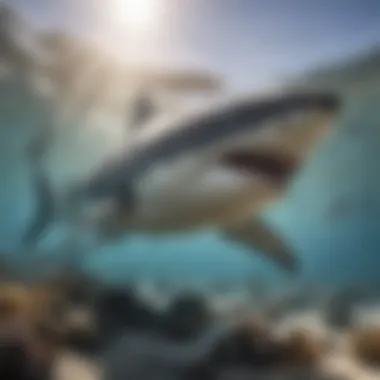
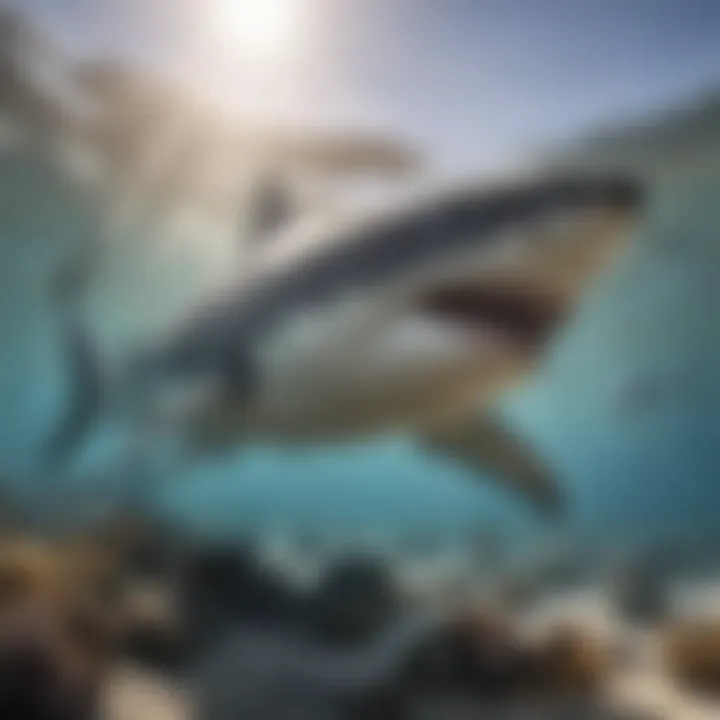
Incorporating Science into Community Programs
Integrating science into community programs can create a more informed public. For instance, biologists can collaborate with local schools to develop science curricula focused on local marine life, including sharks. When students understand the significance of sharks in food webs, they value them more highly.
Another approach is organizing citizen science projects where community members can participate in data collection efforts. Imagine local divers working alongside marine biologists to study shark populations or habitat conditions. This hands-on experience not only educates but also fosters a sense of ownership and responsibility toward marine ecosystems.
Here are some specific community initiatives:
- School Presentations: Marine biologists can visit classrooms to discuss the importance of sharks and the threats they face.
- Beach Clean-Up Events: Teaching about the connection between pollution and shark health while engaging the community in positive action.
- Social Media Campaigns: Using platforms like Facebook to share compelling stories or visuals that highlight shark conservation efforts.
Case Studies of Successful Conservation
Exploring case studies of successful conservation efforts provides vital insights into how targeted actions can influence shark populations positively. These examples offer not only proof of concepts but also a foundation to build upon for future conservation initiatives. Among the numerous benefits of examining successful cases are understanding best practices, recognizing challenges overcome, and demonstrating the broad impacts of effective marine biology interventions.
Restoration of Shark Populations
The restoration of shark populations stands as a testament to what can be achieved through diligent research and strategic action. A notable example involves the recovery of the lemon shark populations in the Bahamas. These sharks were once on the decline due to overfishing and habitat degradation. Marine biologists took proactive steps by establishing protected areas where fishing was restricted and habitats were restored.
Among the key elements of this restoration were:
- Habitat Protection: Protecting critical breeding and nursery grounds led to increased juvenile populations.
- Community Engagement: Local communities were brought on board to understand the importance of sharks in tourism and ecology, creating allies instead of adversaries in conservation.
- Ongoing Monitoring: Regular data collection allowed for real-time adjustments to management strategies, ensuring better outcomes.
Results from these efforts have been promising; the shark populations have shown significant recovery, demonstrating that conservation can work with the right frameworks in place. This success story inspires ongoing efforts and validates the role of marine biologists in these complex processes.
Impact of Marine Protected Areas
Marine Protected Areas (MPAs) provide another successful case study, where specific regions of the ocean are off-limits to various harmful activities. A prominent example is the Great Barrier Reef in Australia, which includes extensive areas designated as protected. Research conducted in these MPAs has shown remarkable benefits not just for sharks, but for entire marine ecosystems.
Key impacts of MPAs include:
- Increased Biodiversity: Protected areas support a wider range of marine life, contributing to a more resilient ecosystem.
- Biomass Recovery: Studies have indicated that sites within MPAs often have a higher biomass of larger fish and, consequently, sharks, highlighting the importance of habitat conservation.
- Enhanced Research Opportunities: MPAs provide ideal settings for long-term research and studies, allowing marine biologists to track changes over time effectively.
By merging ecological benefits and community interests, successful MPAs illustrate the vital role of marine biologists in managing shark conservation efforts. These examples underscore the necessity for careful planning and implementation of conservation strategies, providing vital lessons for future initiatives.
Future Directions in Shark Research
The future of shark research holds great potential, particularly as the pressures on these species intensify due to environmental changes and human activity. As marine ecosystems alter, understanding the trends and dynamics affecting shark populations is of utmost importance. Innovations in research methods can offer insights that traditional approaches may miss. Thus, exploring these future directions in shark research becomes essential for both conservation strategies and species survival.
Emerging Technologies in Research
In recent years, emerging technologies have been making waves in the field of marine biology, particularly in the realm of shark research. Tools like genetic analysis and more sophisticated tracking systems are paving the way for more detailed understanding of shark behaviors, migration patterns, and breeding habits. The introduction of satellite tracking, for instance, enables researchers to monitor shark movements in real-time, providing data that was once impossible to gather.
- Genomics and Environmental DNA (eDNA)
– This technology has become a game changer, allowing scientists to detect shark presence in an area without needing to physically see them. Collecting samples of water can reveal genetic material shed by the sharks, leading to an inventory of species in a specific habitat. - Underwater Drones
– These innovations serve as eyes in the water, helping scientists observe shark populations in their natural habitats without disturbing them. Drones capture high-definition footage, making it easier to analyze behaviors and interactions that were tough to document during traditional field studies.
By maintaining a finger on the pulse of technological advancements, marine biologists can tailor their methodologies and enhance their conservation strategies, making them still more effective.
Collaborative Approaches to Conservation
Shark conservation is not a solo endeavor. It often takes a village — or, more aptly, an ocean of collaboration. Joining forces across different disciplines and sectors can amplify the impact of conservation efforts. Marine biologists, local communities, NGOs, and government agencies must look at sharks from various perspectives.
- Community Involvement
– Collaboration with local communities ensures that those who have the most interaction with sharks become part of the solution. Educating fishermen about sustainable practices and engaging them in conservation efforts creates a sense of ownership. These individuals can offer invaluable insights based on their years of experience in the waters. - Interdisciplinary Research Initiatives
– Joining forces with ecologists, geologists, and climate scientists enriches the data pool, leading to more comprehensive studies. For instance, understanding how climate change impacts ocean temperatures and currents can help predict how shark migratory patterns will shift. - Global Partnerships for Research Funding
– Collaborating internationally enables marine biologists to tap into broader funding sources and grants. Through shared resources, projects can span larger geographic areas, tackling broader conservation challenges that individual researchers may not be capable of handling alone.
The synergy created by collaboration breeds innovative ideas and solutions that can reshape the future landscape of shark research and conservation efforts, ensuring these majestic creatures have a fighting chance.
In essence, as marine biologists navigate the shifting sands of research environments, being equipped with advanced technologies and a collaborative mindset positions them better to protect sharks in the future.
Ending
In wrapping up our discussion on shark conservation, it’s crucial to highlight the intricate and pivotal role that marine biologists play in these efforts. The conclusion serves as a touchstone that brings together all the strands of knowledge and insight shared throughout the article. The importance of this topic can't be overstated, as the ongoing plight of sharks is intricately linked with marine biodiversity and the health of oceanic ecosystems.
Summary of Key Insights
Throughout our exploration, several key insights emerged:
- Sharks as Ecological Linchpins: Sharks are often referred to as apex predators, underscoring their role in maintaining the balance of marine environments. Their presence indicates a healthy ecosystem, which is foundational for diverse marine life.
- Capacity for Recovery: Many shark species show resilience when given a fighting chance. Through effective conservation programs led by marine biologists, some shark populations demonstrate signs of recovery, reinforcing the value of these initiatives.
- Technological Advances: The advent of cutting-edge technologies in research—like satellite tracking and underwater drones—has vastly improved the ability to study and protect sharks. This tech-centric approach fosters more informed decision-making.
- Community Engagement: Marine biologists are crucial in bridging the gap between scientific research and public understanding. By engaging communities and schools in education programs, they ensure that the significance of sharks is appreciated beyond academia.
The Importance of Marine Biologists in Shark Conservation
Marine biologists serve not just as scientists, but as vital advocates for the oceans and their inhabitants. Their expertise enables them to:
- Conduct Rigorous Research: This research forms the basis for understanding shark behavior, reproduction, and health, all of which are key to their conservation.
- Influence Policy Changes: Armed with robust data, marine biologists frequently drive policy reforms that protect shark habitats and mitigate threats like overfishing and pollution.
- Educate and Mobilize: Their role in education helps to demystify sharks, combating unfounded fears and promoting a culture of respect and conservation.
Through these efforts, the impact of marine biologists resonates far beyond their immediate research and actions; it extends into shaping societal attitudes towards sharks and fostering a more sustainable future. The ongoing collaboration between marine biologists, government entities, and the community is essential for ensuring these magnificent creatures can thrive again.
The struggle to protect sharks is not just a conservation issue; it's a crucial aspect of ensuring the overall health of our oceans—our planet's lifeblood.















